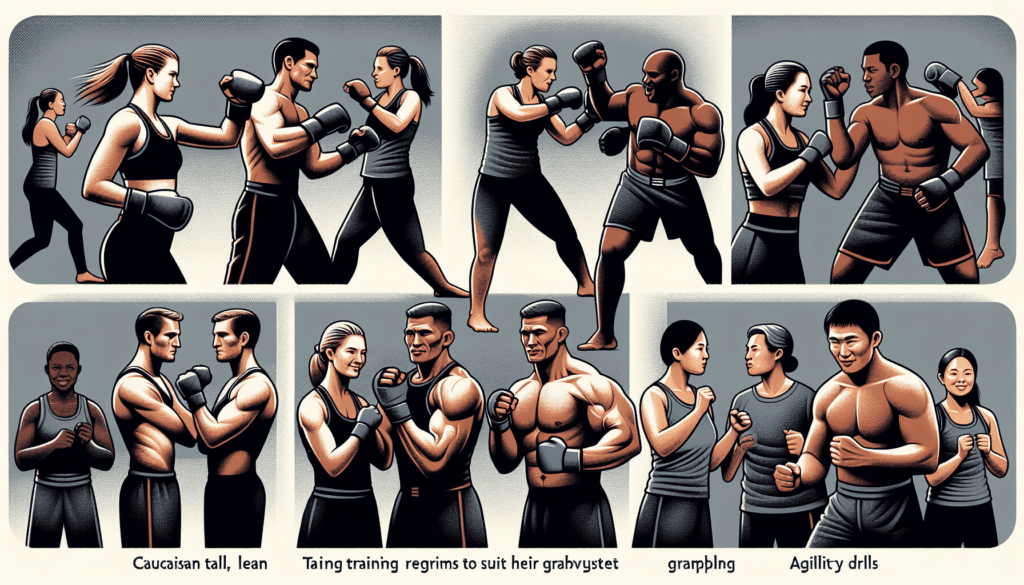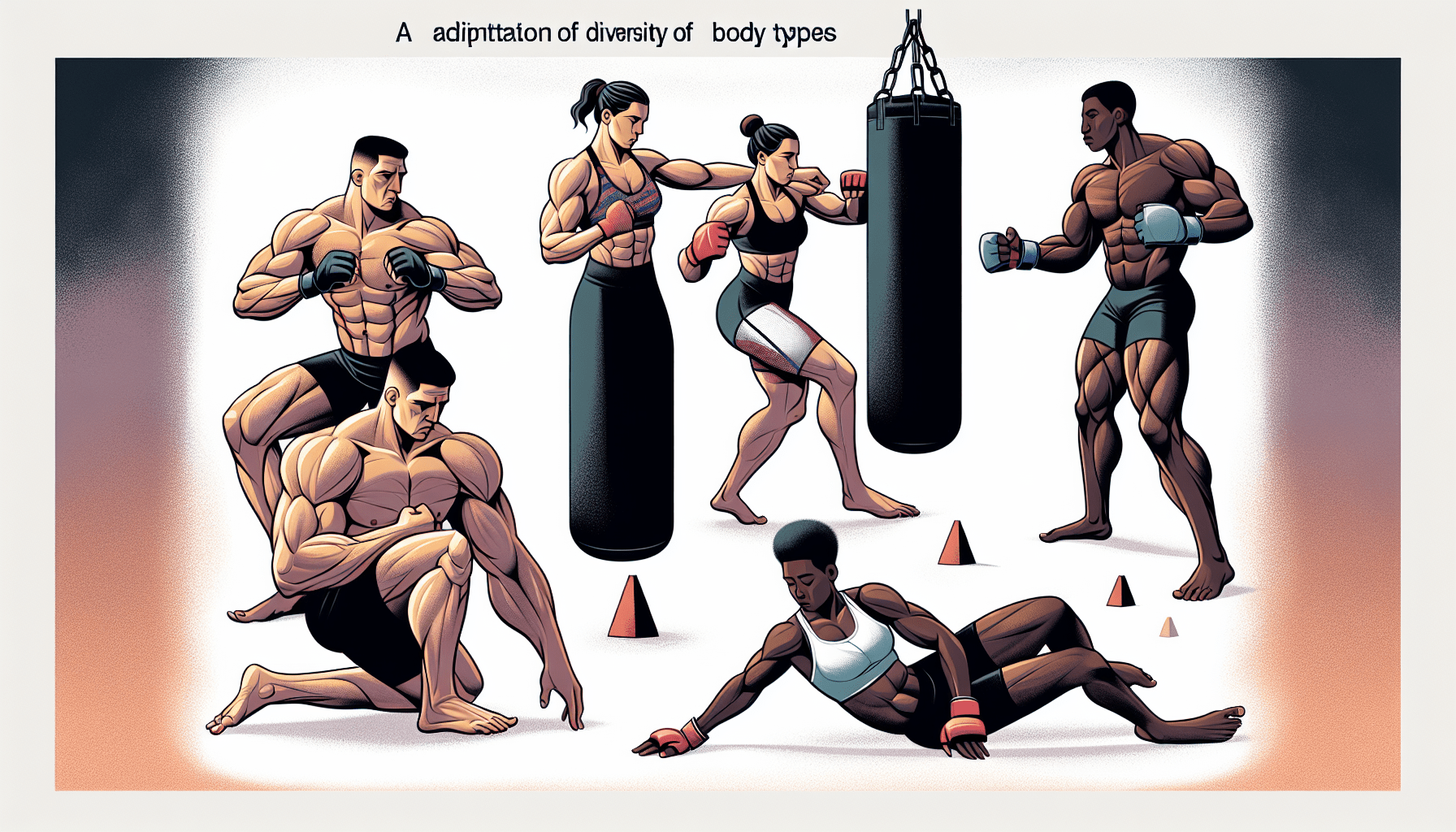Welcome to a beginner’s guide on how to adapt your MMA training for different body types. Whether you are tall and lean, shorter and stocky, or somewhere in between, understanding how to tailor your workouts to your specific body type will help you maximize your potential in the sport. From adjusting your stance and striking techniques to incorporating the right kind of strength and conditioning exercises, this article will provide you with valuable insights and tips to take your MMA training to the next level. So, let’s dive in and learn how to optimize your training for your unique physique. Have you ever wondered how to adapt your MMA training for different body types as a beginner? It can be challenging to figure out the best approach when starting out in mixed martial arts, especially if you have a unique body type. In this article, we will explore various strategies and tips to help you tailor your training to suit your individual needs. Whether you are tall, short, muscular, or lean, there are ways to optimize your workouts and improve your skills in the octagon. Let’s dive in and discover how you can make the most of your MMA training based on your body type.
Understanding Different Body Types in MMA
Before we delve into specific training strategies, it’s essential to understand the various body types commonly seen in MMA. While everyone’s physique is unique, fighters often fall into one of the following categories:
- Endomorph: Typically characterized by a higher body fat percentage and a tendency to gain weight easily.
- Mesomorph: Typically muscular and athletic, with a natural inclination to build muscle and strength.
- Ectomorph: Typically lean and slender, with difficulty gaining muscle mass.
Identifying your body type can help you customize your training regimen to maximize your strengths and address any weaknesses. Keep in mind that most individuals have a combination of these body types, with one dominant trait. By recognizing your unique characteristics, you can tailor your workouts to achieve optimal results in the cage.
Assessing Your Body Type
Determining your body type is the first step in adapting your MMA training effectively. Here are some general guidelines to help you identify where you fall on the spectrum:
-
Endomorph:
- You tend to carry excess body fat, especially around the midsection.
- You may have a larger frame and thicker bones.
- Gaining muscle is relatively easy, but losing fat can be a challenge.
-
Mesomorph:
- You have a naturally muscular build with well-defined muscles.
- You gain muscle mass quickly and respond well to strength training.
- Your body is generally well-proportioned and athletic.
-
Ectomorph:
- You are lean with a fast metabolism and difficulty gaining weight.
- Your body is long and slender, with narrow shoulders and hips.
- Building muscle mass can be a struggle, requiring a specific approach to training and nutrition.
Embracing Your Body Type
Once you have determined your body type, it’s important to embrace your unique characteristics and work with them, rather than against them. Remember that there is no one-size-fits-all approach to MMA training, and what works for one fighter may not be suitable for another. By understanding your strengths and weaknesses, you can tailor your workouts to suit your body type and make the most of your training sessions. Now let’s explore how to adapt your MMA training based on your specific physique.
Training Strategies for Different Body Types
Each body type requires a slightly different approach to training to achieve optimal results. By customizing your workouts to suit your physique, you can improve your performance in the cage and enhance your overall martial arts skills. Let’s break down some training strategies for endomorphs, mesomorphs, and ectomorphs, respectively.
Training for Endomorphs
Endomorphs often struggle with losing excess body fat while building muscle mass. To optimize your MMA training as an endomorph, focus on high-intensity workouts that burn calories and increase lean muscle mass. Here are some specific training strategies for endomorphs:
| Training Strategy | Description |
|---|---|
| Cardiovascular Exercise | Incorporate regular cardio sessions to boost your metabolism and burn fat. Aim for high-intensity interval training. |
| Strength Training | Focus on compound exercises that target multiple muscle groups simultaneously, such as squats, deadlifts, and bench press. |
| Mobility Work | Include mobility drills and dynamic stretches to improve flexibility and prevent injuries. |
| Nutrition and Recovery | Pay attention to your diet and recovery strategies to maintain muscle mass while shedding excess body fat. |
By combining these training strategies with a well-rounded MMA program, endomorphs can improve their conditioning, strength, and overall performance in the octagon.
Training for Mesomorphs
Mesomorphs are naturally muscular and athletic, making them well-suited for MMA training. To capitalize on your genetic advantages as a mesomorph, focus on strength and power development, along with skill-specific drills. Here are some training strategies for mesomorphs:
| Training Strategy | Description |
|---|---|
| Strength and Power Training | Emphasize explosive movements and power exercises to enhance your athletic abilities and physical dominance. |
| Skill Development | Dedicate time to mastering technique and refining your combat skills, such as striking combinations and grappling maneuvers. |
| Cross-Training | Experiment with different fighting styles and training modalities to expand your skill set and challenge yourself. |
| Injury Prevention | Prioritize proper form and technique to reduce the risk of injuries, especially when training at high intensity. |
By incorporating these training strategies into your routine, mesomorphs can build on their natural strengths and become well-rounded fighters in the MMA arena.
Training for Ectomorphs
Ectomorphs often struggle with gaining muscle mass and may find it challenging to compete with larger opponents in MMA. To overcome these obstacles, focus on muscle hypertrophy, strength gains, and skill development as an ectomorph. Here are some training strategies for ectomorphs:
| Training Strategy | Description |
|---|---|
| Hypertrophy Training | Follow a structured weightlifting program aimed at building muscle mass through progressive overload and volume training. |
| Nutrition and Recovery | Consume a high-protein diet and prioritize post-workout nutrition to support muscle growth and recovery. |
| Skill Acquisition | Focus on mastering technique and strategy to compensate for size and strength disadvantages in the cage. |
| Functional Training | Incorporate functional movements and agility drills to improve your speed, explosiveness, and overall athleticism. |
By tailoring your training program to target muscle growth, strength development, and technical proficiency, ectomorphs can overcome their physical limitations and excel in the world of MMA.

Tips for Adapting Your MMA Training
Regardless of your body type, there are some general tips that can help you adapt your MMA training for optimal results. By incorporating these strategies into your routine, you can enhance your skills, improve your fitness level, and maximize your performance in the cage. Here are some tips for adapting your MMA training as a beginner:
-
Set Specific Goals: Define your objectives and create a realistic training plan to achieve them. Whether you aim to improve your striking, grappling, or conditioning, setting clear goals can guide your progress and keep you motivated.
-
Listen to Your Body: Pay attention to your body’s signals and adjust your training intensity and volume accordingly. Rest and recovery are crucial for preventing injuries and ensuring long-term progress in MMA.
-
Work with a Coach: Consider working with a qualified coach or trainer who can provide personalized guidance, feedback, and support. A knowledgeable instructor can help you refine your technique, design effective workouts, and navigate the complexities of MMA training.
-
Stay Consistent: Consistency is key to making progress in MMA. Stay committed to your training regimen, attend classes regularly, and put in the work to improve your skills over time.
-
Adapt and Evolve: Be willing to adapt your training program as needed based on your progress, feedback, and changing goals. MMA is a dynamic sport that requires continuous learning and adaptation to stay competitive.
By implementing these tips and adjusting your training approach to suit your body type, you can enhance your performance in MMA and reach your full potential as a fighter.
Conclusion
Adapting your MMA training for different body types as a beginner is essential for maximizing your potential in the octagon. By understanding your unique characteristics and customizing your workouts accordingly, you can optimize your performance, improve your skills, and overcome physical limitations. Whether you are an endomorph, mesomorph, or ectomorph, there are specific strategies you can employ to enhance your training and achieve success in mixed martial arts. Remember to focus on your strengths, address your weaknesses, and stay committed to your goals as you embark on your MMA journey. Use the knowledge and tips provided in this article to tailor your training regimen to suit your body type, and watch yourself grow and evolve as a martial artist. With dedication, perseverance, and the right training approach, you can become a formidable force in the world of MMA and achieve your dreams in the sport.


